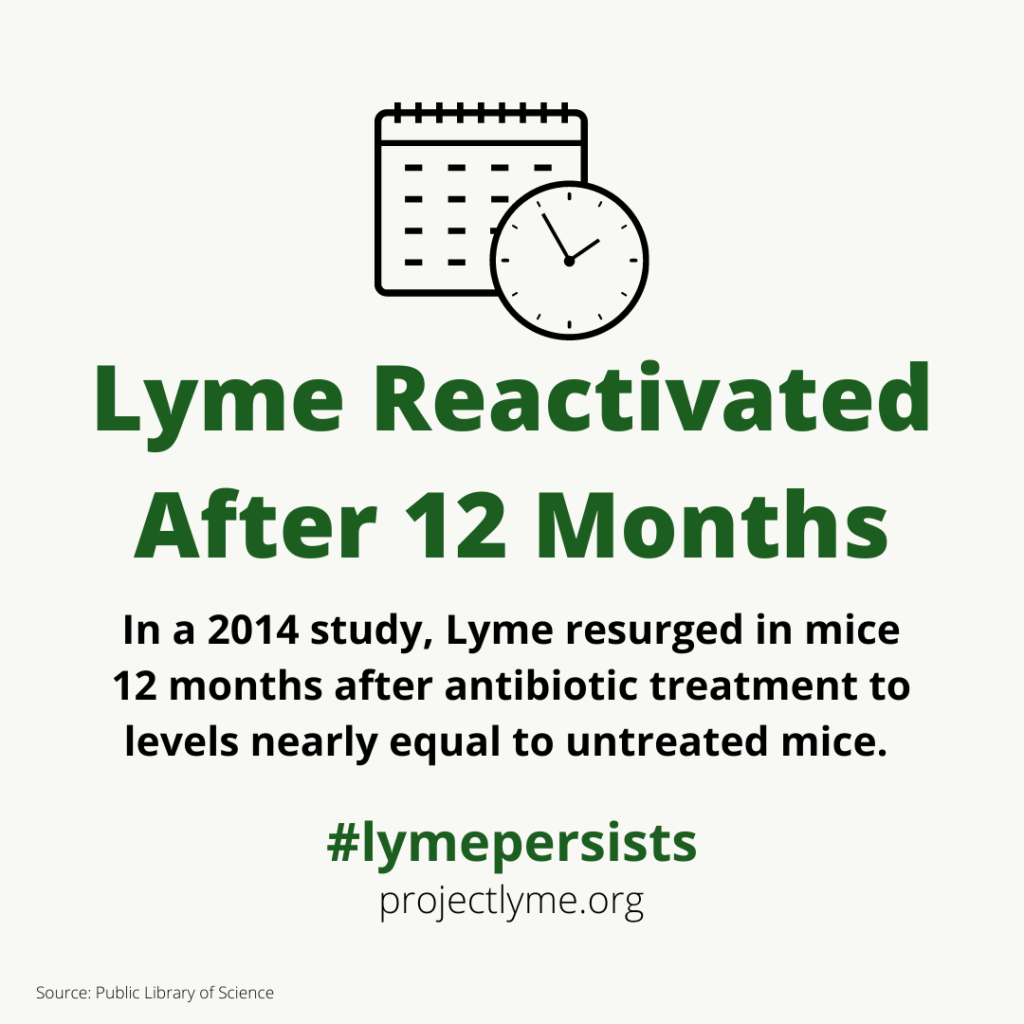12 MONTHS AFTER ANTIBIOTIC TREATMENT
LYME REACTIVATED


Background:
Studies in dogs, mice, non-human primates, and humans have found Borrelia burgdorferi DNA and spirochetes in tissues for months following treatment with CDC recommended antibiotics. These persistent spirochetes however are extremely difficult to grow in culture, indicating that (for unknown reasons) they do not replicate much or at all, though they were grown from antibiotic-treated primates in a study in 2012, and from antibiotic-treated humans in 1990.
Before the usage of methods like PCR to detect the DNA of spirochetes (cork-screw shaped bacteria), antibiotic treatment of animals infected with B. burgdorferi was considered successful when the outcome was based on not being able to grow spirochetes from tissues in culture. (reviewed here on pages 229-252).
A 2009 article speculated that persistent, non-cultivable spirochetes:
- would eventually die out after treatment,
- are non-pathogenic and do not cause disease/inflammation
These speculations were made in spite of a study showing that the ability to culture B. burgdorferi from infected primates decreases significantly with duration of infection, regardless of antibiotic treatment, and despite the fact that in the normal course of events, B. burgdorferi infects multiple tissues without inflammation.
Those speculations were refuted in a 2010 study where B. burgdorferi DNA was transmitted by ticks from antibiotic-treated mice to uninfected mice, and by transplanting tissue from treated mice into uninfected mice. B. burgdorferi DNA disseminated in the recipient mice.
Resurgence of Persisting Non-Cultivable Borrelia burgdorferi following Antibiotic Treatment in Mice
A 2014 study sought to determine the long-term fate of these persistent, non-cultivable (unable to be grown in culture) spirochetes, and their effects on mice. 48 mice were infected with B. burgdorferi. At 30 days of infection, half were treated with a CDC recommended antibiotic for 30 days, and half were treated with just saline.
Mice from each group were autopsied at 2, 4, 8, and 12 months after treatment. Saline-treated mice were nearly all culture-positive (meaning they could be grown in culture) and were PCR-positive at all intervals and in most tissues. None of the antibiotic treated mice were culture-positive at any interval after treatment, and only a few tissue sites were PCR-positive at 2, 4, or 8 months, though DNA copy numbers were low.
At 12 months, all mice from both groups were PCR-positive at multiple tissue sites, and DNA copy numbers were nearly equivalent in antibiotic treated and saline treated mice, suggesting a resurgence of spirochetes despite antibiotic treatment. These spirochetes were found to be transcribing multiple B. burgdorferi genes. All controls tested negative, including mice that were inoculated with B. burgdorferi that had been killed by heat.
Antibody levels declined over time in both groups (also seen in this study), with no evidence of an increase in antibiotic-treated mice at 8 or 12 months despite the resurgence of spirochetes.
The authors theorized that the resurgence of non-cultivable B. burgdorferi spirochetes at 12 months may be related to declining antibody response. Antibodies have been shown to be critical for resolution of arthritis and carditis, as well as the reduction of spirochete burdens in tissues.
Due to little or no inflammation in mice from both groups, the authors used cytokines to evaluate host response, which indicated a pro-inflammatory cytokine state in both groups of mice 12 months after treatment. A 2012 study showed that spirochete antigens persist in tissues of antibiotic-treated mice, which suggests the persistent B. burgdorferi spirochetes were responsible for the pro-inflammatory state.
One week prior to mice being autopsied, larval ticks fed on each mouse. The ticks were allowed to molt and become nymphs, which were PCR-positive at all intervals in both treatment groups. Ticks that fed upon both groups of mice at 12 months were dissected, revealing intact B. burgdorferi spirochetes.
Despite the presence of B. burgdorferi DNA at 12 months after treatment, the authors of the study struggled to find spirochetes in the tissues of both saline-treated mice and the antibiotic-treated mice. Cardiac connective issue from one antibiotic treated mouse did however contain intact, antigen-reactive spirochetes.
The authors of the study cautioned that the findings were controversial and “should not be over-interpreted and certainly not translated directly into clinical management” of Lyme disease in humans. However, they went on to stress that persistent B. burgdorferi-specific DNA has been documented after antibiotic treatment in humans in multiple studies (one, two, three, four, five, six).
Key Takeaways:
- B. burgdorferi spirochetes resurged in antibiotic-treated mice 12 months after treatment, to levels near that of saline-treated mice.
- Antibody levels waned over time in both groups of mice, and remained low in antibiotic-treated mice despite the resurgence of spirochetes. This suggests that in persistent and chronic infections, antibody tests can yield false negatives.